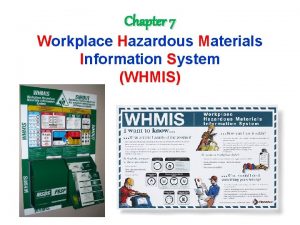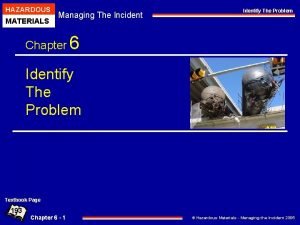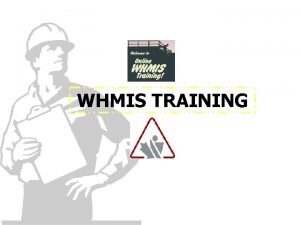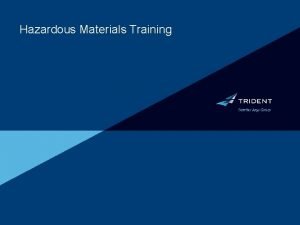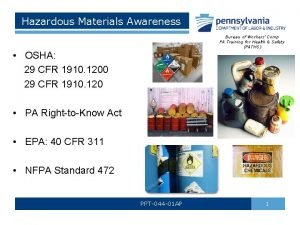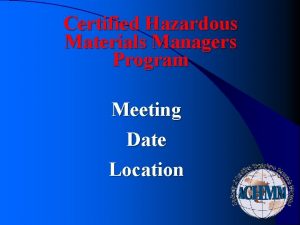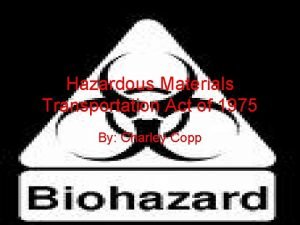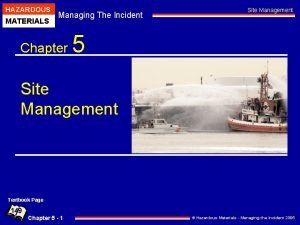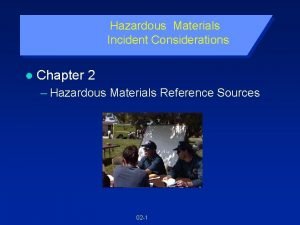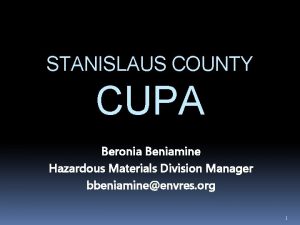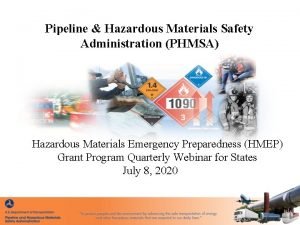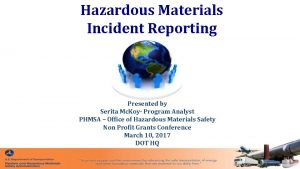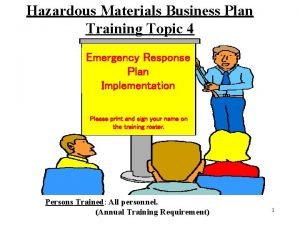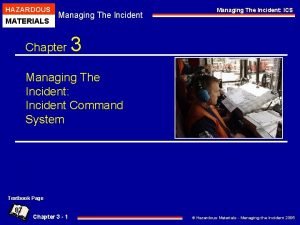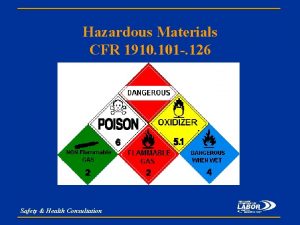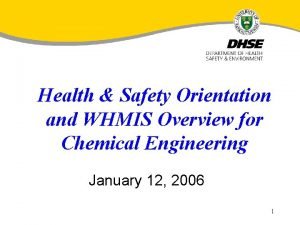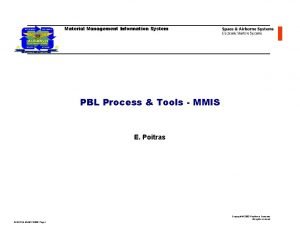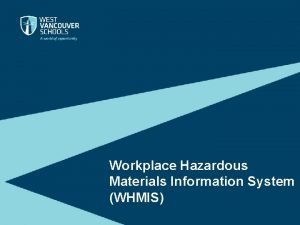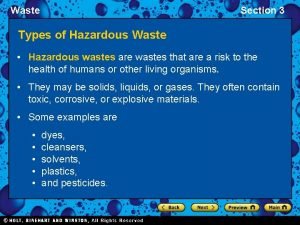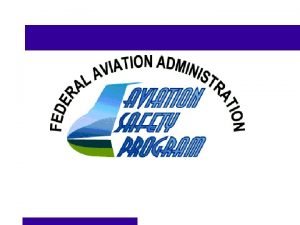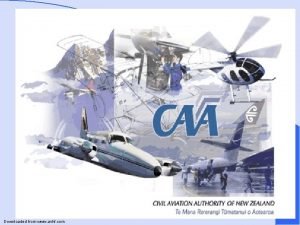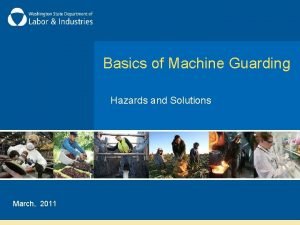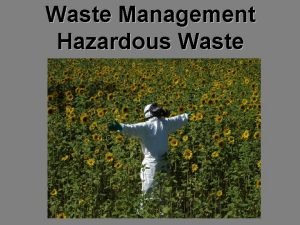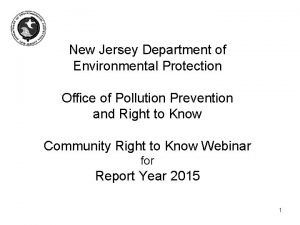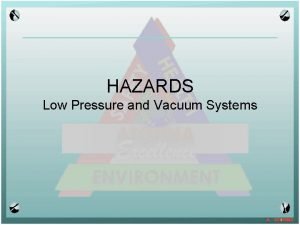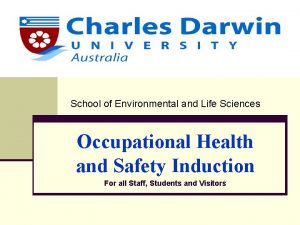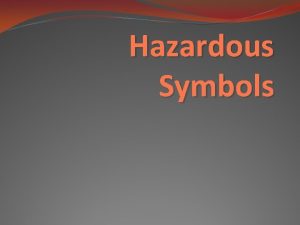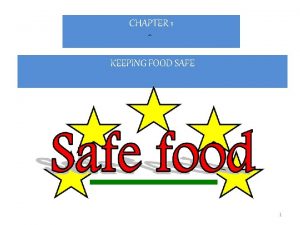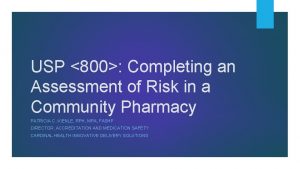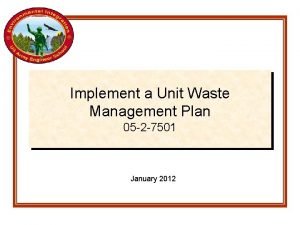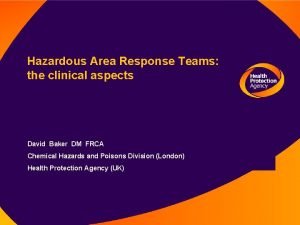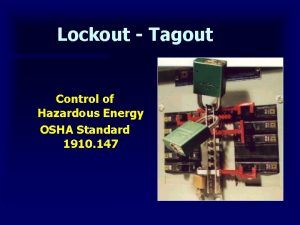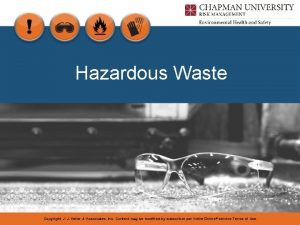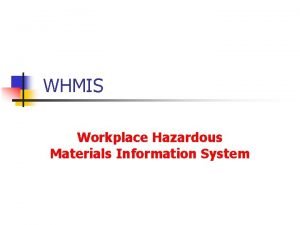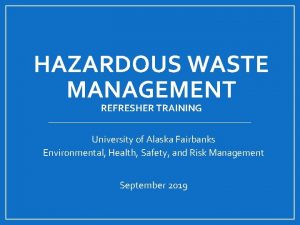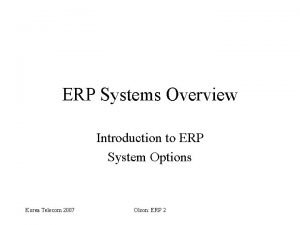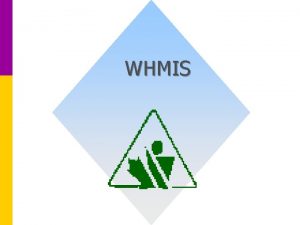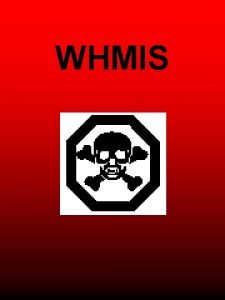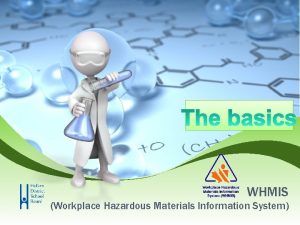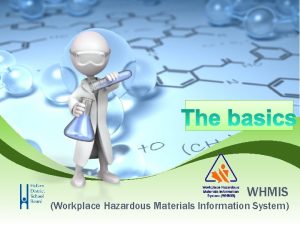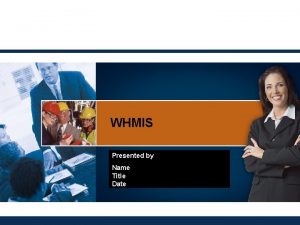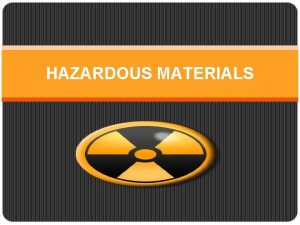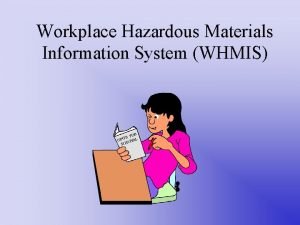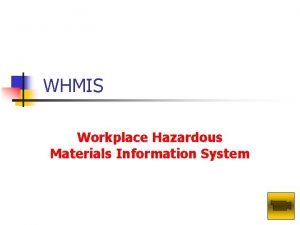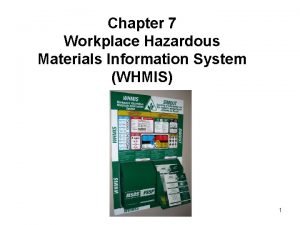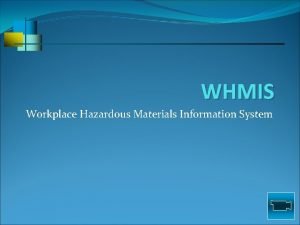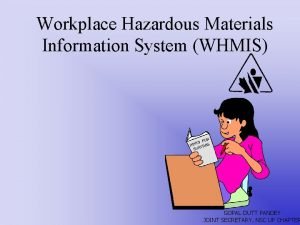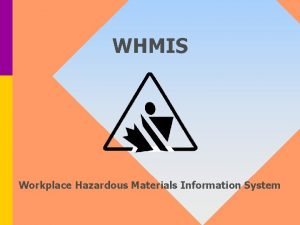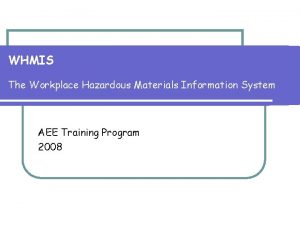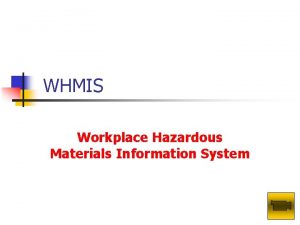WHMIS Workplace Hazardous Materials Information System OVERVIEW The

















































- Slides: 49

WHMIS (Workplace Hazardous Materials Information System)

OVERVIEW The Workplace Hazardous Materials Information System (WHMIS) provides information about many hazardous materials used in the workplace. WHMIS calls these hazardous materials controlled products. Under WHMIS, workers have the right to receive information about each controlled product they use – its identity, hazards, and safety precautions. The goal of WHMIS is to reduce injury and disease by communicating specific health and safety information about controlled products so that the information can be used to reduce exposure to hazardous materials.

Federal and Provincial Legislation The Federal WHMIS legislation came into effect on October 30, 1988 under the Hazardous Products Act and four other pieces of federal legislation. WHMIS came into effect in Ontario on October 31, 1988 as a Regulation under the Occupational Health and Safety Act (OHSA). In Ontario, the WHMIS Regulation applies to all workplaces that are covered by the OHSA and is enforced by the Ministry of Labour. The federal workplaces are inspected by Labour Canada, which enforces WHMIS under its jurisdiction. 1 2 3 4 Controlle d Products Ingredient Disclosur e List Hazardou s Materials Informatio n Review Act Hazardou s Materials Informatio n Review

3 Basic Elements of WHMIS 1. WHMIS Labels on controlled products alert workers to the identity of the product, hazards, and precautionary measures. 2. Material Safety Data Sheets (MSDS) Technical bulletins which provide detailed hazard and precautionary information. 3. WHMIS Training and Education The employer provides education and training for workers so that they can work safely with and near controlled products. Workers need to know how WHMIS works, the hazards of controlled products in their workplace, and the safe work procedures they must follow.

Key WHMIS Participants SUPPLIERS EMPLOYERS WORKERS Classify all controlled products Educate and train workers Understand content and significance of labels and MSDS Supply proper labels and MSDS Provide safe work procedures Keep information on labels and MSDS current Ensure availability of proper up-to-date labels and MSDS Follow safe work procedures and WHMIS requirements Notify employers about problems with labels and MSDS

WHMIS Elements WHMIS controlled products are classified by their hazard. There are six hazard classes and eight hazard symbols that identify the specific hazards (there are three symbols in Class D). The eight hazard symbols identify the specific hazards of controlled products.

CLASS A: Compressed Gas • Gas under pressure • Examples: • Butane, propane, acetylene, and fire extinguishers • Hazards: • If a pressurized container is punctured because it is dropped or exposed to excessive heat, the exploding fragments or rocket-like projectiles present a serious physical hazard • Heat may cause container to explode • Container may explode if dropped

CLASS B: Flammable and Combustible Materials • May catch fire or explode • Examples: • Acetone, isopropyl alcohol, stoddart solvent • Hazards: • Flammables are more dangerous than combustibles because they ignite more easily • During use, they must be kept away from ignition sources such as sparks or open flames • When not in use, they must be stored in fire-resistant cabinets or other specified storage areas

CLASS C: Oxidizers • Products causing or contributing to the combustion of other materials • Examples: • Hydrogen peroxide, potassium nitrate, sodium chlorate • Hazards: • Oxidizing materials greatly increase the risk of fire if they come in contact with materials that can burn • They should never be stored near flammable or combustible materials

CLASS D: Poisonous and Infectious Materials This class has 3 divisions: D 1, D 2 and D 3 D 1: Materials causing immediate and serious toxic effects D 2: D 3: Materials Causing Other Toxic Effects Bio hazardous Infectious Material

CLASS D 1: Materials Causing Immediate and Serious Effects • Poisonous, may be fatal • Examples: • Arsenic, methylene chloride, formaldehyde • Hazards: • May be fatal if inhaled, swallowed or absorbed through skin • May burn skin or eyes upon contact

CLASS D 2: Materials Causing Other Toxic Effects • Poisonous, but not immediately dangerous to health • Chronic health effects on body organs, cardiovascular or nervous system • Examples: • Carcinogens (asbestos, crystalline silica, benzene) sensitizers (methyl methacrylate) embroyotoxin (xylene) • Hazards: • Repeated exposure may cause death or permanent injury • May be a skin irritant or sensitizer causing allergic reaction • May cause birth defects, cancer, reproductive problems, or impairment of body organs and systems

CLASS D 3: Bio Hazardous Infectious Materials • May cause serious disease, resulting in death or illness • Classified as Risk Groups II, III or IV as defined by the Medical Research Council of Canada • Examples: • Commercial cultures containing infectious organisms such as HIV, Ebola, and Hepatitis B • Hazards: • Microorganisms (includes viruses, bacteria, fungi) can cause disease in persons and animals. • They may be present in cultures. • Products containing bio hazardous infectious materials may be found in laboratory and research facilities associated with the medical or agricultural sectors.

CLASS E: Corrosive Materials • Caustics or acids causing severe irritation and burns to skin or eyes • Examples: • Sodium hydroxide, hydrochloric acid, hydrofluoric acid • Hazards: • Corrosive materials can cause permanent damage (e. g. , burns) to skin and eyes • May be harmful if inhaled • May eat through metal

CLASS F: Dangerously Reactive Materials • Products that can undergo dangerous reaction if subject to heat, light, pressure, shock, water or air • Examples: • Hydrogen cyanide, vinyl acetate, chlorine dioxide • Hazards: • Products in this class are very unstable • They can undergo vigorous polymerization reaction on their own, or become self-reactive when exposed to shock or to increase in pressure or temperature • It also includes products that react strongly with water to release a toxic gas

WHMIS Labels The purpose of labels is to alert workers to the main hazards of controlled products and provide instructions for safe handling, and to direct workers to the MSDS for more information. • • • All WHMIS controlled products must be labelled There are 2 types of WHMIS Labels • Supplier Labels • Workplace Labels Other means of identification • Placards, warning signs, colour codes • Labels alert workers to hazards and safe handling instructions

Supplier Labels Suppliers must provide supplier labels on containers of all controlled products sold or imported for use in the workplace. • Supplier labels will show seven types of information within the WHMIS hatched border. • The label must be clearly separated by a border to stand out from the container itself and other markings on the container (i. e. , the size of the label should be appropriate for the size of the container). Supplier Labels contain the following: • Product name • Hazard symbols • Risk phrases • Precautionary measures • First Aid measures • Supplier identifier • Reference to MSDS All information must be disclosed in English and French within a hatched border

Acceptable Format for the Supplier Label Product Identifier Hazard Symbol(s) Risk Phrases Precautionary Statement(s) First Aid Measures Supplier Identifier Reference to the MSDS Hatched Border

Workplace Labels Workplace labels are required on containers of controlled products produced on site, and on secondary containers where the product has been transferred from the original container. Workplace labels are applied to: • Secondary containers • Containers of products received in bulk • Containers with missing or illegible supplier labels Workplace labels contain the following: • Product name • Safe handling procedures • Reference to the MSDS

Examples of Labels Supplier Label Example Workplace Label Example

MSDS (Material Safety Data Sheet) A Material Safety Data Sheet is a technical bulletin that provides specific hazard information, safe handling information, and emergency procedures for a controlled product. Since the MSDS contains detailed health and safety information specific to each controlled product, it should be used as a key source of information for developing training programs and safe work procedures. It is also a valuable source of health and safety information for workers, health and safety committees, and emergency service personnel. Examples of information included: • Hazardous ingredients • Hazards (fire, explosion, reactivity) • Health effects of exposure (acute and chronic) • Hazard evaluation related to storage and handling • Measures to protect workers • Emergency procedures § MSDSs must be current (no more than 3 years old), complete, and readily available to workers § The MSDS must be made available and accessible to all workers.

Where to Find an MSDS Employers may use an electronic database to store MSDSs. In this case, it is essential that workers are provided information on accessing such a database to retrieve an MSDS. A hard copy of the MSDS should always be on hand when working with a controlled product in case electronic files are not accessible (e. g. , the system is down). The MSDS: • Provides detailed information on the hazards of a controlled product • An important element for developing safe work procedures and control measures • A key element of worker education and training Halton District School Board uses “MSDS Request” on My. HDSB to store electronic copies of all MSDS.

Partial Exemptions Some products are already covered by other labelling legislation and do not require WHMIS labels and MSDSs. However, Provincial legislation requires employers to educate and train workers about the hazards of partially exempt products, and safe work procedures. Partially exempt products still require Workplace Labels. • • No WHMIS Supplier Label and MSDS Required Education & Training and Workplace Labels Required Examples: • • Some Consumer Products Cosmetics Food and Drugs Medical Devices Radioactive Substances Pesticides Explosives

Complete Exemptions Some products are completely excluded from both Federal and Provincial WHMIS requirements. However, workers must be advised of hazards and be trained in safe handling procedures, as required under other provisions of the Occupational Health and Safety Act. • None of the WHMIS Requirements Apply Examples • Wood and Products made of Wood • Manufactured Articles • Tobacco and Tobacco Products • Hazardous Wastes • Goods Handled Under TDG • Hazardous Materials in Transport

WHMIS and Consumer Products Consumer products are typically packaged and used for personal and household purposes. Suppliers and employers do not have to comply with the WHMIS label and MSDS requirements for consumer products, but workers must understand the hazards and safe use of them. Although not legally required, most consumer products will have an MSDS available. The obligation includes: • Ensuring that the worker has read and understood the consumer product labels. • Ensuring that the worker would recognize the different consumer product labels. • Ensuring that training is provided for the use, handling, storage and disposal of the consumer product(s).

WHMIS and Consumer Products Partial exemption of WHMIS applies to the following conditions: 1. The product must be packaged in a size normally available to consumers in a retail outlet. 2. The product must be available to the general public; wholesale outlets are not considered to be available to the public. 3. The product must be labelled to comply with the requirements for hazardous consumer products. 4. Health and safety precautions must still be taken. 5. The employer’s training obligations apply to any consumer product containing controlled substances used in a workplace.

Consumer Product Labels on consumer products must appear in both English and French. Hazard information must be clearly separated from the rest of the container by a border. Most of the labels on products for consumer use sold in Canada meet the criteria set out for WHMIS workplace labels, namely: 1. The product is identified and the supplier / manufacturer’s name and address are included 2. Information is given on the safe handling of the product 3. Safety information is on the label, including: hazard warnings, instructions and directions for First Aid

Consumer Product Categories and Symbols NO SYMBOL REQUIRE D Category 1: Toxic or Poisonous Substances The symbol used for all toxic materials is the skull & crossbones inside an octagonal border. The 8 -sided border indicates “STOP” and take precautions listed on the label. Category 2: Corrosive Substances The symbol used for all corrosive materials is the hand skeleton inside an octagonal border. The 8 -sided border indicates “STOP” and take precautions listed on the label Category 3: Flammable substances The symbol used for all flammable materials is a flame inside an octagonal border. The 8 -sided border indicates “STOP” and take precautions listed on the label. Category 4: Quick Skin Bonding Adhesive Labels with specific warnings are required. The glue must be in a childresistant container or enclosed in a child-resistant outer package. Category 5: Pressurized Container The products bearing this symbol either contain a liquid or gas under pressure. Consumer products bearing this symbol will include aerosol cans. The symbol used for all pressurized containers is an exploding image in a triangle indicating “WARNING”. A label with specific warnings is required.

WHMIS Quiz In order to complete the training, you must pass the following quiz. You must get 100% on the quiz in order to pass the training.

What does WHMIS stand for? A) Workers Health Manual in Safety B) Workplace Hazardous Materials Information System C) Workplace Hazard Materials Investigation Service D) Workplace Health Management Information System Correct - Click anywhere to continue Your answer: Incorrect - Click anywhere to continue You did not answer this question You answered this correctly! The. You correct answer is: the question completely Try again must answer before continuing Submit Clear

What are the most important aspects of WHMIS? A) Safety rules B) Hazardous materials C) Labels, MSDS and Education D) Wellness Correct - Click anywhere to continue Your answer: Incorrect - Click anywhere to continue You did not answer this question You answered this correctly! The. You correct answer is: the question completely Try again must answer before continuing Submit Clear

What governing body enforces WHMIS legislation in Ontario? A) The Ministry of Labour B) The Ministry of Education C) The Ministry of Health and Safety D) Workplace Safety Board Correct - Click anywhere to continue Your answer: Incorrect - Click anywhere to continue You did not answer this question You answered this correctly! The. You correct answer is: the question completely Try again must answer before continuing Submit Clear

What is the meaning of this symbol? A) Can cause death of a person exposed to small amounts B) Contain harmful microorganisms C) Can cause immediate skin or eye irritation or long -term health effects D) Can cause illness Correct - Click anywhere to continue Your answer: Incorrect - Click anywhere to continue You did not answer this question You answered this correctly! The. You correct answer is: the question completely Try again must answer before continuing Submit Clear

What is the meaning of this symbol? A) Contain harmful microorganisms B) Capable of catching fire or exploding in the presence of ignition sources C) Provide oxygen that can increase the risk of fire D) Can cause a severe burn Correct - Click anywhere to continue Your answer: Incorrect - Click anywhere to continue You did not answer this question You answered this correctly! The. You correct answer is: the question completely Try again must answer before continuing Submit Clear

What is the meaning of this symbol? A) Caustics or acids that can destroy skin or eat metals B) Will make your skin itch C) Can explode if exposed to heat or impact D) Wash hands and avoid touching surfaces Correct - Click anywhere to continue Your answer: Incorrect - Click anywhere to continue You did not answer this question You answered this correctly! The. You correct answer is: the question completely Try again must answer before continuing Submit Clear

What does the border around this symbol mean? A) Danger B) Caution C) Warning D) Safe Correct - Click anywhere to continue Your answer: Incorrect - Click anywhere to continue You did not answer this question You answered this correctly! The. You correct answer is: the question completely Try again must answer before continuing Submit Clear

What does this symbol stand for? A) A pirate treasure location symbol B) A consumer product symbol warning of a toxic or poisonous substance C) A supplier label symbol for warning of death to exposure D) A manufacturing symbol warning of death Correct - Click anywhere to continue Your answer: Incorrect - Click anywhere to continue You did not answer this question You answered this correctly! The. You correct answer is: the question completely Try again must answer before continuing Submit Clear

What does this symbol stand for? A) Oxiders B) Corrosive material C) Dangerously Reactive material D) Flammable/Combustible material Correct - Click anywhere to continue Your answer: Incorrect - Click anywhere to continue You did not answer this question You answered this correctly! The. You correct answer is: the question completely Try again must answer before continuing Submit Clear

What does this symbol stand for? A) Explosive material B) Bio hazardous infectious material C) Clean chemical container D) Acetone Correct - Click anywhere to continue Your answer: Incorrect - Click anywhere to continue You did not answer this question You answered this correctly! The. You correct answer is: the question completely Try again must answer before continuing Submit Clear

What does this symbol stand for? A) Compressed gas B) Sterile containers C) Explosive containers D) Clean chemical container Correct - Click anywhere to continue Your answer: Incorrect - Click anywhere to continue You did not answer this question You answered this correctly! The. You correct answer is: the question completely Try again must answer before continuing Submit Clear

This symbol refers to which hazard? A) Oxidizing materials greatly increase the risk of fire B) Materials may become self-reactive when exposed to an increase in pressure or temperature C) These materials can pose a danger of catching fire D) Campfires are okay here Correct - Click anywhere to continue Your answer: Incorrect - Click anywhere to continue You did not answer this question You answered this correctly! The. You correct answer is: the question completely Try again must answer before continuing Submit Clear

What is the purpose of a WHMIS label? A) To alert workers to stop work immediately B) To keep an organized inventory C) To alert workers to hazards of controlled products D) To alert workers that the chemical is safe Correct - Click anywhere to continue Your answer: Incorrect - Click anywhere to continue You did not answer this question You answered this correctly! The. You correct answer is: the question completely Try again must answer before continuing Submit Clear

What are the two types of WHMIS labels? A) Distributer label and employer label B) Manufacturer label and package label C) Supplier label and workplace label D) Manufacturer label and HDSB label Correct - Click anywhere to continue Your answer: Incorrect - Click anywhere to continue You did not answer this question You answered this correctly! The. You correct answer is: the question completely Try again must answer before continuing Submit Clear

What does MSDS stand for? A) Manufacturer’s Safety Determination Standard B) Material Safety Data Sheet C) Management Saving Data System D) Managing Safety Descriptions System Correct - Click anywhere to continue Your answer: Incorrect - Click anywhere to continue You did not answer this question You answered this correctly! The. You correct answer is: the question completely Try again must answer before continuing Submit Clear

Who should know where MSDSs are kept? A) Administrators and Supervisors only B) Custodial staff C) All workers D) Facilities Services Department Correct - Click anywhere to continue Your answer: Incorrect - Click anywhere to continue You did not answer this question You answered this correctly! The. You correct answer is: the question completely Try again must answer before continuing Submit Clear

How often must an MSDS be updated? A) Every year and as soon as new information on a product is available B) Every 2 years and as soon as new information on a product is available C) Every 3 years and as soon as new information on a product is available D) Once a month Correct - Click anywhere to continue Your answer: Incorrect - Click anywhere to continue You did not answer this question You answered this correctly! The. You correct answer is: the question completely Try again must answer before continuing Submit Clear

There are seven types of information on a supplier label. What answer below is false? A) Precautionary measures B) The recipe and ingredients C) Risk phrases D) First aid measures Correct - Click anywhere to continue Your answer: Incorrect - Click anywhere to continue You did not answer this question You answered this correctly! The. You correct answer is: the question completely Try again must answer before continuing Submit Clear

What languages must appear on Supplier labels? A) English and French B) English and Italian C) English and Spanish D) All (English, Italian, French, Spanish) Correct - Click anywhere to continue Your answer: Incorrect - Click anywhere to continue You did not answer this question You answered this correctly! The. You correct answer is: the question completely Try again must answer before continuing Submit Clear

CONGRATULATIONS!!! You have successfully completed the training and passed the WHMIS Quiz IMPORTANT!!! Now that you have completed this training, click the confirm button below to submit the certificate of completion to our database. CONFIRM
 Shape and color of whmis 2015 symbols
Shape and color of whmis 2015 symbols Us military marking system for hazardous materials
Us military marking system for hazardous materials Whmis workplace label
Whmis workplace label Hazmat table
Hazmat table Hazardous materials table
Hazardous materials table Hazwoper
Hazwoper Certified hazardous materials manager
Certified hazardous materials manager Hazardous materials transportation act of 1975
Hazardous materials transportation act of 1975 Hazardous materials managing the incident
Hazardous materials managing the incident Hazardous materials reference books
Hazardous materials reference books Stanislaus county hazardous materials division
Stanislaus county hazardous materials division Pipeline and hazardous materials administration
Pipeline and hazardous materials administration Hazardous materials incident report
Hazardous materials incident report Hazardous materials business plan
Hazardous materials business plan Hazardous materials managing the incident
Hazardous materials managing the incident Compressed gas association pamphlet p 1 1965
Compressed gas association pamphlet p 1 1965 Whmis overview
Whmis overview Materials management information system
Materials management information system What does sds stand for whmis
What does sds stand for whmis Favourite cars
Favourite cars What are useful materials at home
What are useful materials at home Man made map
Man made map What is adopting materials
What is adopting materials Direct materials budget with multiple materials
Direct materials budget with multiple materials Section 3 hazardous waste answers
Section 3 hazardous waste answers Aviation hazardous attitudes
Aviation hazardous attitudes Hazardous waste neha
Hazardous waste neha Five hazardous attitudes
Five hazardous attitudes Hazardous attitudes
Hazardous attitudes Hazardous mechanical motion
Hazardous mechanical motion Hazardous waste apes
Hazardous waste apes What is toxic waste
What is toxic waste Nj crtk environmental hazardous substances
Nj crtk environmental hazardous substances Low pressure vacuum
Low pressure vacuum Hazardous area training darwin
Hazardous area training darwin Hazardous symbols
Hazardous symbols Keeping food safe chapter 1
Keeping food safe chapter 1 Hazardous drug api
Hazardous drug api On july 18 2001 a train carrying hazardous chemicals
On july 18 2001 a train carrying hazardous chemicals Segregation of hazardous waste
Segregation of hazardous waste Hazardous area response teams
Hazardous area response teams Hazardous movement asl
Hazardous movement asl Solid and hazardous waste
Solid and hazardous waste Noaa experimental forecast
Noaa experimental forecast Tagout
Tagout Keller hazardous waste disposal
Keller hazardous waste disposal Hazardous chemicals
Hazardous chemicals Rcra hazardous waste refresher
Rcra hazardous waste refresher Erp system overview
Erp system overview Content database software
Content database software
